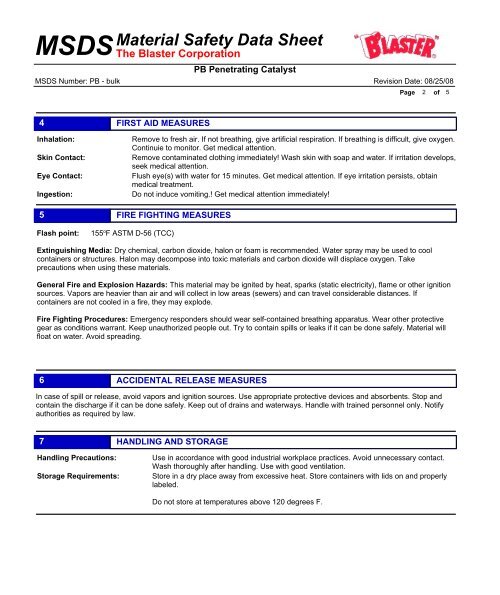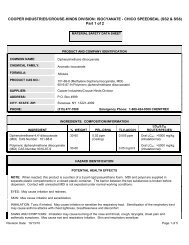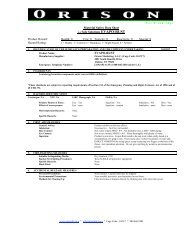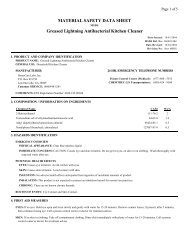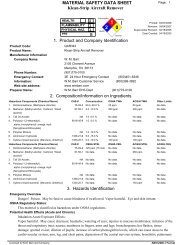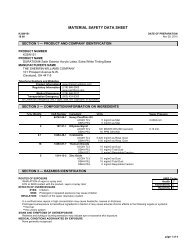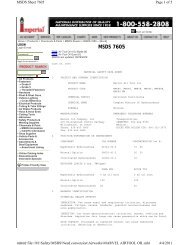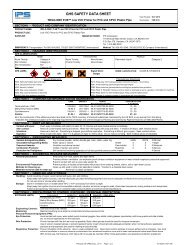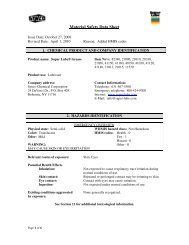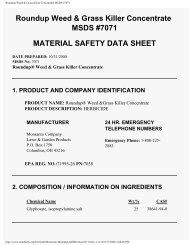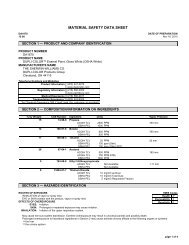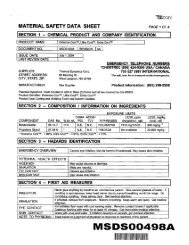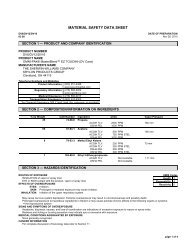PB Blaster
PB Blaster
PB Blaster
You also want an ePaper? Increase the reach of your titles
YUMPU automatically turns print PDFs into web optimized ePapers that Google loves.
Material Safety Data Sheet<br />
MSDS The <strong>Blaster</strong> Corporation<br />
<strong>PB</strong> Penetrating Catalyst<br />
MSDS Number: <strong>PB</strong> - bulk<br />
Revision Date: 08/25/08<br />
Page<br />
2 of 5<br />
4<br />
Inhalation:<br />
Skin Contact:<br />
Eye Contact:<br />
Ingestion:<br />
5<br />
Flash point:<br />
FIRST AID MEASURES<br />
Remove to fresh air. If not breathing, give artificial respiration. If breathing is difficult, give oxygen.<br />
Continuie to monitor. Get medical attention.<br />
Remove contaminated clothing immediately! Wash skin with soap and water. If irritation develops,<br />
seek medical attention.<br />
Flush eye(s) with water for 15 minutes. Get medical attention. If eye irritation persists, obtain<br />
medical treatment.<br />
Do not induce vomiting.! Get medical attention immediately!<br />
FIRE FIGHTING MEASURES<br />
155 o F ASTM D-56 (TCC)<br />
Extinguishing Media: Dry chemical, carbon dioxide, halon or foam is recommended. Water spray may be used to cool<br />
containers or structures. Halon may decompose into toxic materials and carbon dioxide will displace oxygen. Take<br />
precautions when using these materials.<br />
General Fire and Explosion Hazards: This material may be ignited by heat, sparks (static electricity), flame or other ignition<br />
sources. Vapors are heavier than air and will collect in low areas (sewers) and can travel considerable distances. If<br />
containers are not cooled in a fire, they may explode.<br />
Fire Fighting Procedures: Emergency responders should wear self-contained breathing apparatus. Wear other protective<br />
gear as conditions warrant. Keep unauthorized people out. Try to contain spills or leaks if it can be done safely. Material will<br />
float on water. Avoid spreading.<br />
6<br />
ACCIDENTAL RELEASE MEASURES<br />
In case of spill or release, avoid vapors and ignition sources. Use appropriate protective devices and absorbents. Stop and<br />
contain the discharge if it can be done safely. Keep out of drains and waterways. Handle with trained personnel only. Notify<br />
authorities as required by law.<br />
7<br />
HANDLING AND STORAGE<br />
Handling Precautions:<br />
Storage Requirements:<br />
Use in accordance with good industrial workplace practices. Avoid unnecessary contact.<br />
Wash thoroughly after handling. Use with good ventilation.<br />
Store in a dry place away from excessive heat. Store containers with lids on and properly<br />
labeled.<br />
Do not store at temperatures above 120 degrees F.


